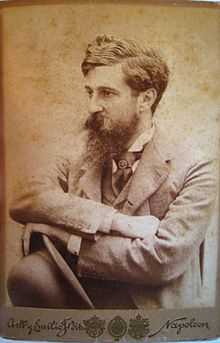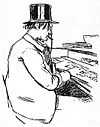Santiago Rusiñol
| Santiago Rusiñol i Prats | |
|---|---|
 Rusiñol in 1892 | |
| Spouse | Lluïsa Denís[1] |
| Nationality | Spanish |
| Field | Painting, Poetry, Theater |
| Training | Studio of Tomás Moragas |
| Movement | Modernisme |
Santiago Rusiñol i Prats (Catalan pronunciation: [səntiˈaɣu ruziˈɲɔɫ]) (February 25, 1861 – June 13, 1931) was a Spanish painter, poet, and playwright. He was one of the leaders of the Catalan modernisme movement.

He influenced Pablo Picasso as a modern artist, and also left a number of modernist buildings in Sitges, a town in Catalonia.
Life

Rusiñol was born in Barcelona in 1861, to a family of industrialists in textiles with origins in Manlleu. Despite the fact that he was the heir to the family's lucrative operations, by the time he was a teenager Rusiñol already showed a strong interest in painting and travel.
His training as painter started at Centro de Acuarelistas de Barcelona under the direction of Tomás Moragas. Like so many artists of the day, he travelled to Paris in 1889, living in Montmartre with Ramon Casas and Ignacio Zuloaga.

He was most known for his plays, and landscape and garden paintings. He died in Aranjuez in 1931 while painting its famous gardens.
References
- ↑ Isabel Coll, 2000.p 62
- ↑ http://books.google.com/books/about/El_archiduque_Luis_Salvador_Rub%C3%A9n_Dar%C3%AD.html?id=iwANAAAAIAAJ&redir_esc=y El archiduque Luis Salvador, Rubén Darío y Santiago Rusiñol en Mallorca
- ↑ "Book mentioning Casa Trinxet". Google Books. 1998-10-27. Retrieved 2012-08-11.
Further reading
- Vázquez, Oscar E., "Beauty Buried in its Own Cemetery: Santiago Rusiñol's ‘Jardins d'Espanya’ as Reliquaries of Aristocratic History." Word & Image 2, no.1 (January–March, 1995), 61-76
External links
| Wikimedia Commons has media related to Santiago Rusiñol. |
- Webpage devoted to Santiago Rusiñol (lletrA (UOC), Catalan Literature Online)
- Web about the Rusiñol Year in Sitges
- Santiago Rusiñol i Prats An extensive view on the life and works of Rusiñol as painter and writer
|